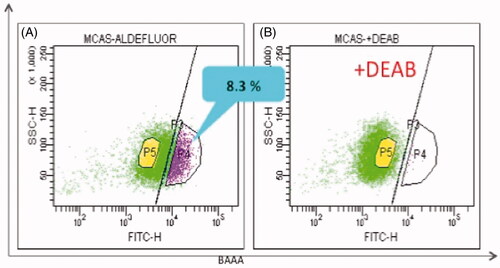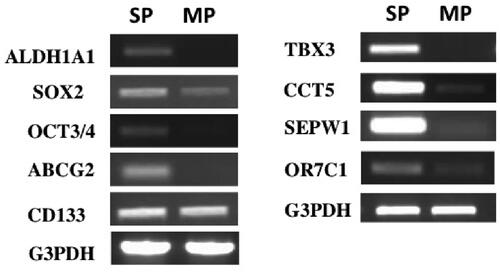Figures & data
Figure 1. Hoechst33342 staining assay that shows CSC-enriched side population. Ovarian carcinoma MCAS cells were stained with 5.0 µg/mL Hoechst 33342 and analysed by flow cytometry. (A) SP, side population (2.2%); MP, main population. (B) SP was decreased in the presence ABCG2 inhibitor verapamil.

Figure 2. ALDEFLUOR assay revealed CSC-enriched ALDH1-positive population. ALDEFLUOR assay kit was purchased from Stem Cell Technologies (Vancouver, BC, Canada). MCAS cells were suspended in 1 mL assay buffer containing 1.5 mM of an ALDH1 substrate, BODIPY®-aminoacetaldehyde and analysed by flow cytometry. (A) ALDH1-high population (8.3%). (B) ALDH1-high population disappeared in the presence of 10-fold molar excess of diethylamino-benzaldehyde (DEAB).

Table I. A list of genes preferentially expressed in CSCs/TICs of solid cancers.
Figure 3. Semi-quantitative RT-PCR analysis of genes expressed in HEC-1 endometrial cancer cells. Total RNAs of side population (SP) and main population (MP) of HEC-1 endometrial cancer cells were reverse transcribed and amplified by using Taq enzyme (QIAGEN). The thermal cycling conditions were 94 °C for 2 min, followed by 35 cycles of 15 s at 94 °C, 30 s at 60 °C, and 30 s at 72 °C.

Figure 4. Immunostaining of tumour tissues showing highly phosphorylated HSF-1 in ALDH1-high tumour cells. Xenograft tumours were obtained by transplantation of ALDH1-high population (A) and ALDH1-low population (B) of HEC-1 cells into NOD/SCID mice. The formalin-fixed tumour tissue sections were stained with anti-phospho-HSF1 (S326) antibody (abcam, Cambridge, UK). Higher nuclear staining in the ALDH-high tumour tissue (A) indicates that HSF1 could be activated in the cells [Citation60].
![Figure 4. Immunostaining of tumour tissues showing highly phosphorylated HSF-1 in ALDH1-high tumour cells. Xenograft tumours were obtained by transplantation of ALDH1-high population (A) and ALDH1-low population (B) of HEC-1 cells into NOD/SCID mice. The formalin-fixed tumour tissue sections were stained with anti-phospho-HSF1 (S326) antibody (abcam, Cambridge, UK). Higher nuclear staining in the ALDH-high tumour tissue (A) indicates that HSF1 could be activated in the cells [Citation60].](/cms/asset/a828e17c-067b-4753-a3c7-2090357426bb/ihyt_a_814809_f0004_b.jpg)
